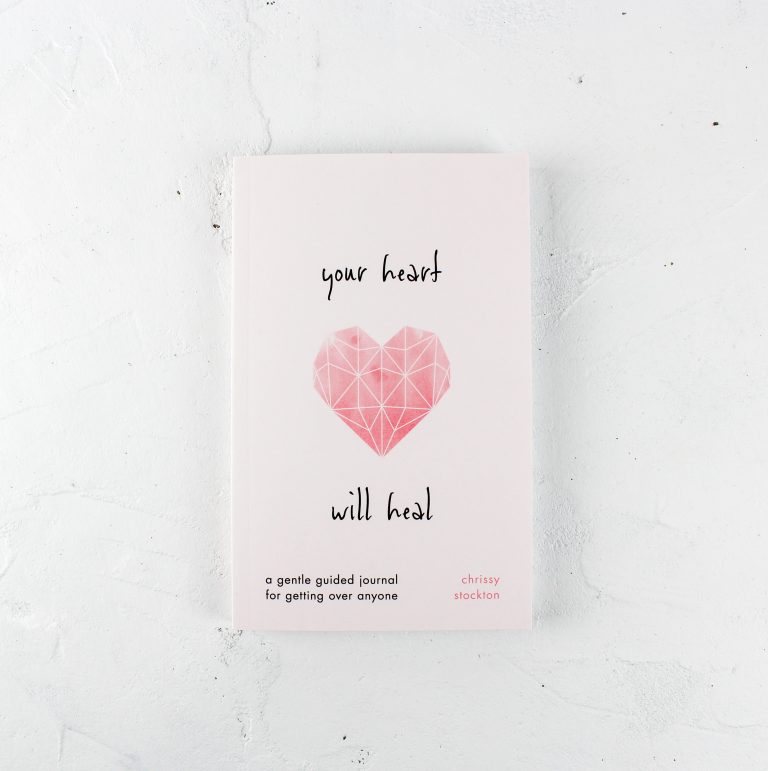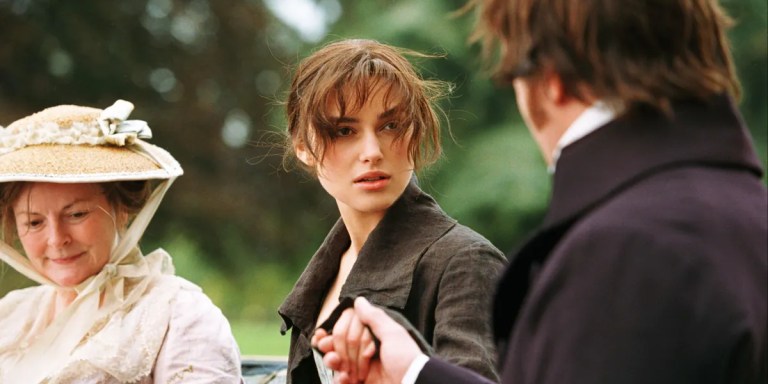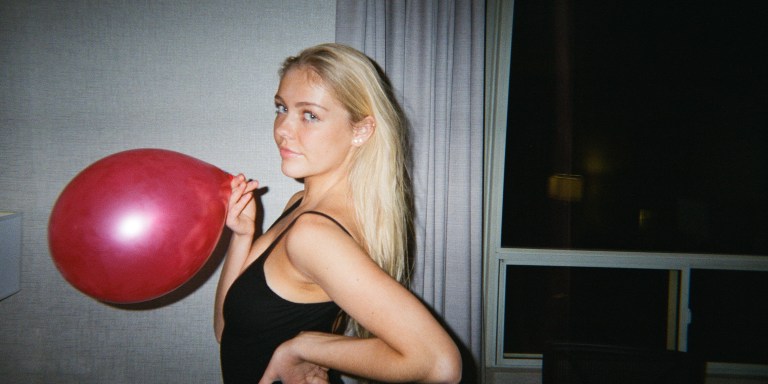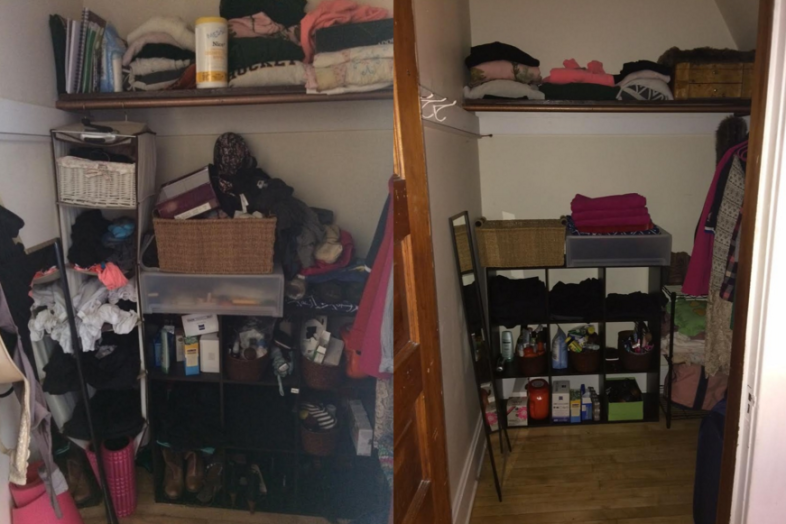
From the moment I heard about Marie Kondo’s book The Life-Changing Magic of Tidying Up: The Japanese Art of Decluttering and Organizing it was going to improve my life. Every time I read about or practice minimalism I reap massive benefits in my life: I’m more focused and relaxed, less scattered and anxious. Kondo’s method (in a nutshell: go through every single item you own, keep only things that actively “spark joy”) seems like a no-brainer if you want to be calmer and happier in your home and your life.
In recovery they tell you to move the body and the mind follows. When you think your mental state can’t change, you have to just keep going through the motions until it does. You just work on removing obstacles until there is less and less between you and a better state of mind. Eventually your mental space catches up with your physical space.
Kondo gets it. She says “people cannot change their habits without first changing their way of thinking” and “when your room is uncluttered you have no choice but to examine your inner state.” We focus on tidying our space not just to be type A and retentive about it, but so that we can cut out the noise that stands between us and a richer, more focused inner life.
I know this. It’s very hard for me to feel put-together when my apartment is a mess, and that usually translates into doing not-put-together actions like procrastinating work, spending outside my budget, eating junk food, not dressing well, being a hermit, etc. Similarly, a simple cleaning session could pull me out of any funk and transport me to a place where I am calm and motivated to do whatever is on the agenda. If I can find the right order for my home to be calm, decluttered, and in a state of order, I can do the same with my mind.
Kondo’s approach to tidying (the KonMari method) is radical. It is to tidy once, in one big session, and then to never tidy again. She claims that through doing this, none of her clients have ever relapsed into mess. And, because of the order their house is in, their lives are better, more focused, and happier.
I was particularly inspired by one of clients who stated her goal for tidying was the end result of a “more feminine life.”
“When I come home from work, the floor would be clear of clutter … and my room, as tidy as a hotel suite with nothing obstructing the line of sight. I’d have a pink bedspread and a white antique-style lamp. Before going to bed, I would have a bath, burn aromatherapy oils, and listen to classical piano or violin while doing yoga and drinking herbal tea. I would fall asleep with a feeling of unhurried spaciousness.”
Who wouldn’t conjure these habits for themselves, if that’s how habits worked? And Kondo’s client did exactly that after she’d completed her tidying project. She took on the habits of her dream life and didn’t relapse. When her space was organized, her mind became organized enough that she could become the person she had always wanted to be.
Here’s my experience with the method, and some tips if you plan to read the book and try it yourself.
How to begin
Kondo’s process is scarily simple:
1. Tidy all at once, in one session
2. Tidy by category, not by room
3. Remove everything from it’s home and discard everything that does not spark joy when you hold it in your hands
4. Find a home for every single item
The idea of wading in my things excites me. I think back to when the main character in High Fidelity was going through a major existential crisis and calmed himself by taking all his records out and organizing them in autobiographical order. There’s something so soothing about that, about remembering the joy in the things that surround us every day. And at the end, when we are surrounded only by items we have gratitude for, which remind us of the joy we have in life, we become the kind of people who feel joy and gratitude putting a sweater away at the end of the day instead of leaving it on the floor. What a dream!
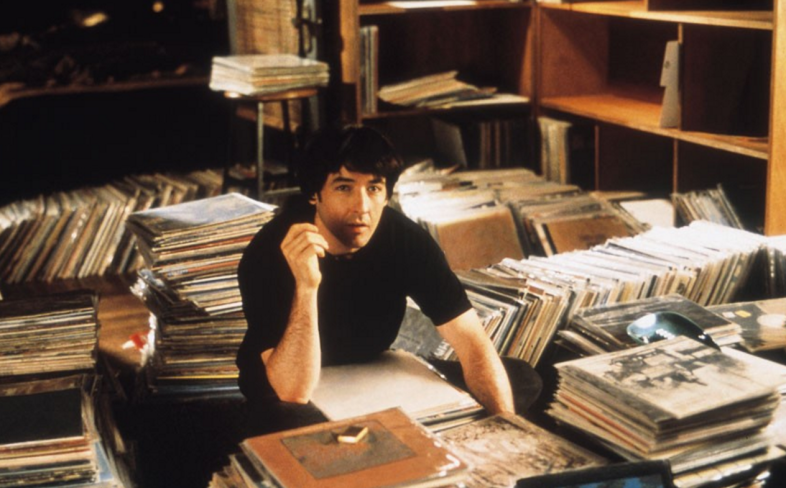
Clothing
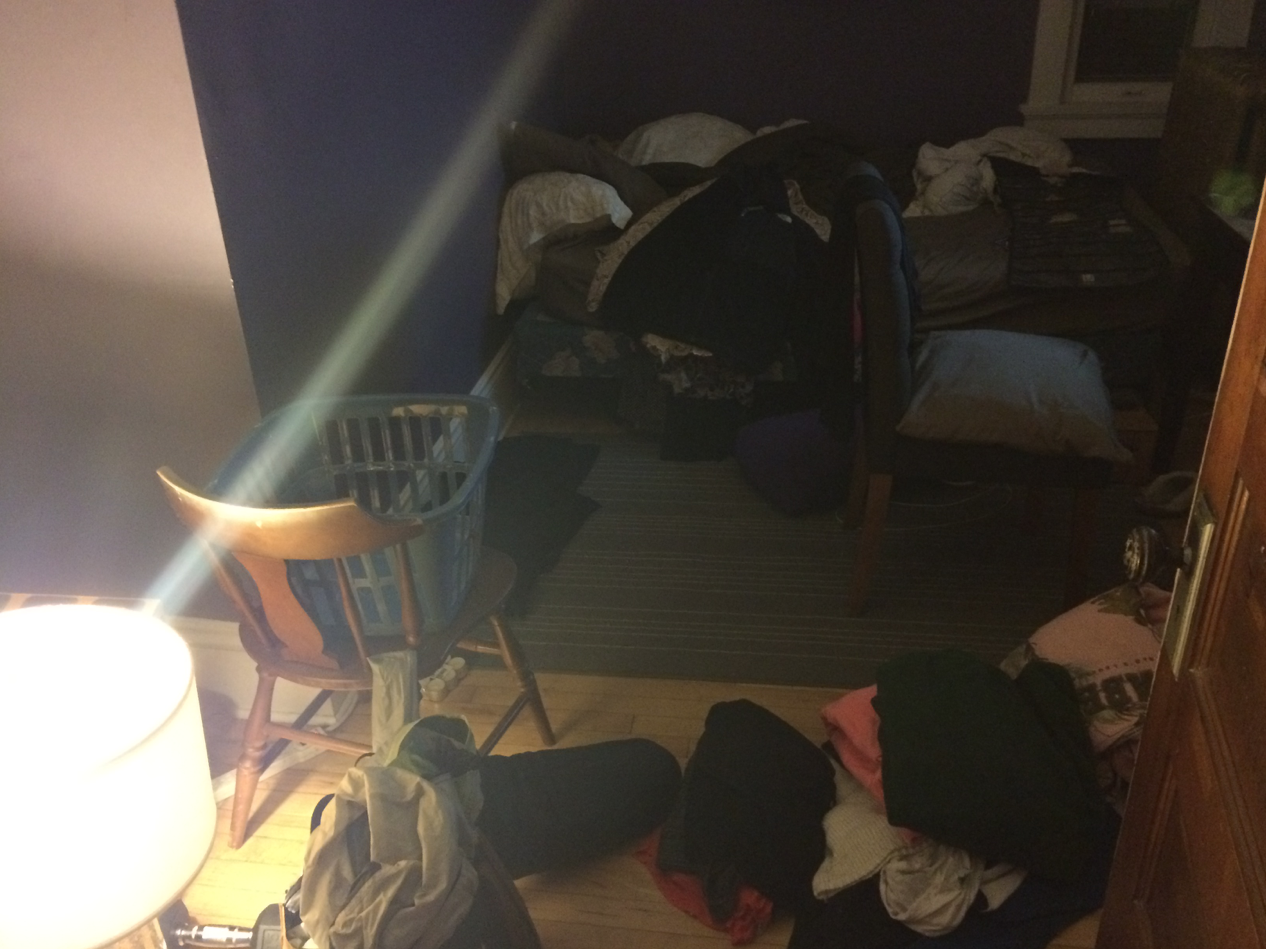
Clothes are definitely the easiest category to start with. The main point of what we are supposed to be doing with the KonMari method (keeping only things that spark joy) is an ethereal question, but it feels least fuzzy to ask this of our clothing.
We know how our clothes make us feel — whether a tattered grey shirt survives purge after purge because it makes us feel happy — while a pristine pair of jeans hangs in our closet unworn because they were a gift from a stylish friend we wished we could emulate, but never will. You’re supposed to remove each item from it’s space, hold it, and determine whether it is a “joy sparker”. Holding each item evokes a feeling, and when we listen to it, we end up with a closet that feels wholly ourselves.
A few common pitfalls Kondo is careful to help us navigate:
1. We don’t need to feel guilty about discarding (donating) new or barely worn clothing. If was a gift it’s purpose in our lives has already been fulfilled. Gift giving is for the giver, whoever gave us the item has already experienced the joy of giving their gift. If it was an item we bought but never wore, it’s purpose has also been fulfilled, we got a “thrill” when we bought it and learned a lesson about what we like and dislike. In both cases we can thank the shirt for serving a purpose and move on without guilt.
2. We tend to think “I will wear this some day.” Kondo’s mantra: “some day” never comes. Don’t discard for the person you want to be, discard for the person you are.
3. For items that are utilitarian and don’t really “spark joy” but we need them: Kondo advises us to not think of joy as a synonym for happiness, but as gratitude. My thick winter hat doesn’t spark joy in me because I love the cold or because I think it’s a particularly pretty hat — but it’s the only one I currently own and it does a great job of keeping me warm so I feel grateful to have it and find a home for it.
The real trick with clothing
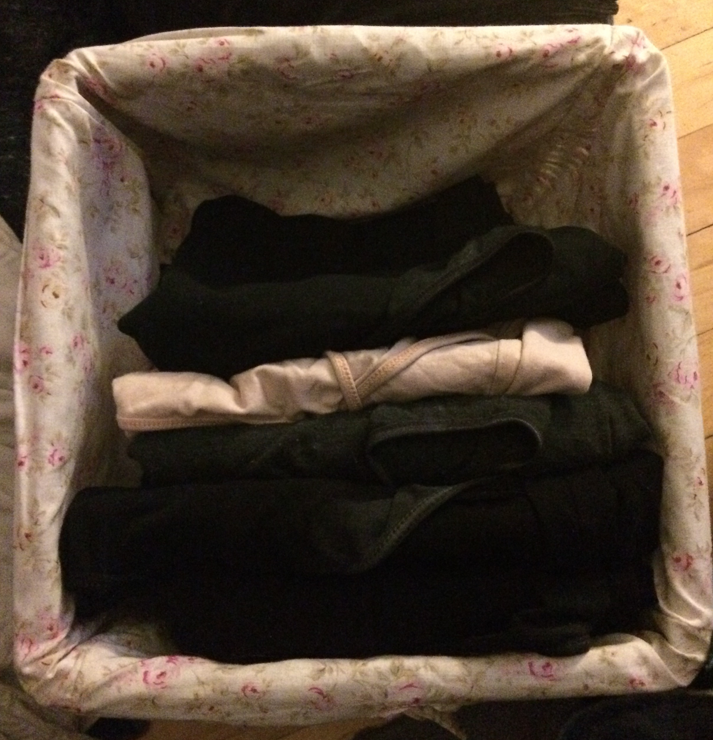
Pay particular attention to how you are storing your items. Kondo folds things vertically, so that if you open a drawer of shirts, you see each shirt in the drawer. You should also fold things gently, and not stack them, so that they have a chance to “rest” between wears. Initially I scoffed at this, but afterwards I do feel a sense of calm in my closet I haven’t felt before, because things aren’t bound or buried or stretched.
It also feels light and wonderful to color coordinate and/or organize your hanging items in ascending order from heaviest (right) to lightest (left) in terms of weight and texture:
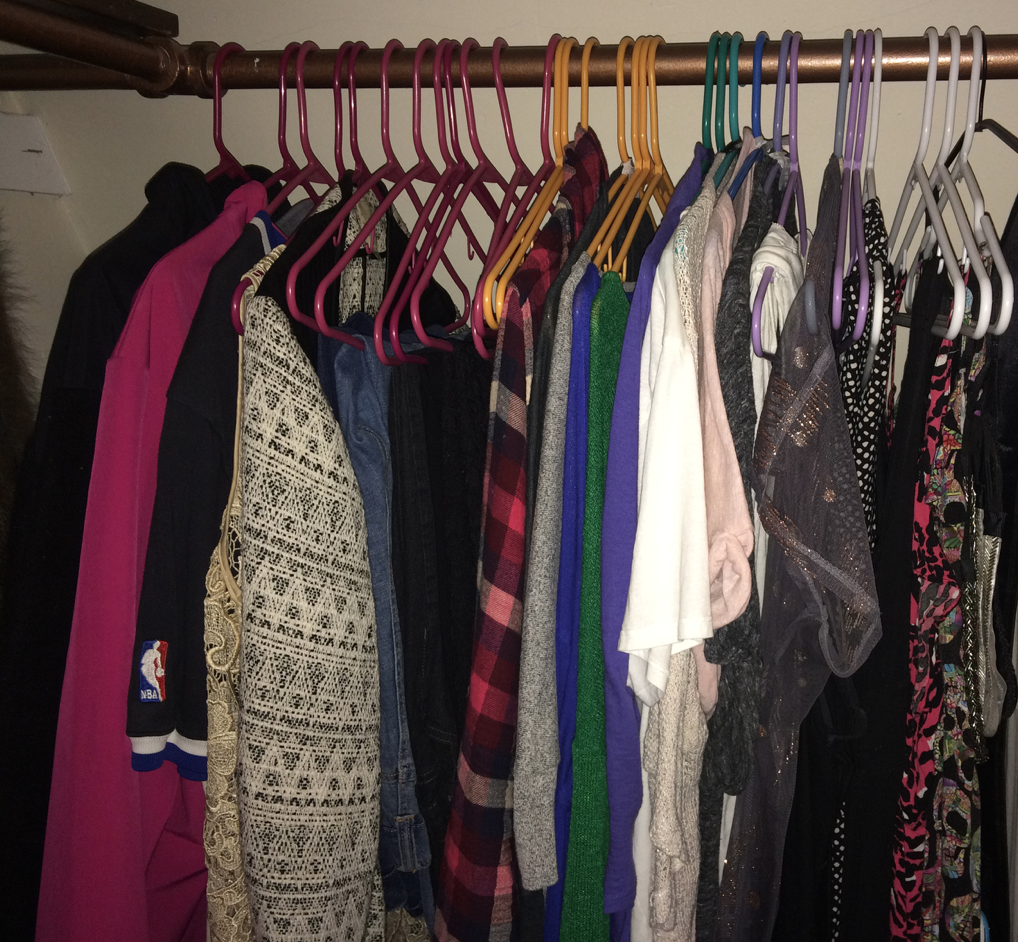
Books
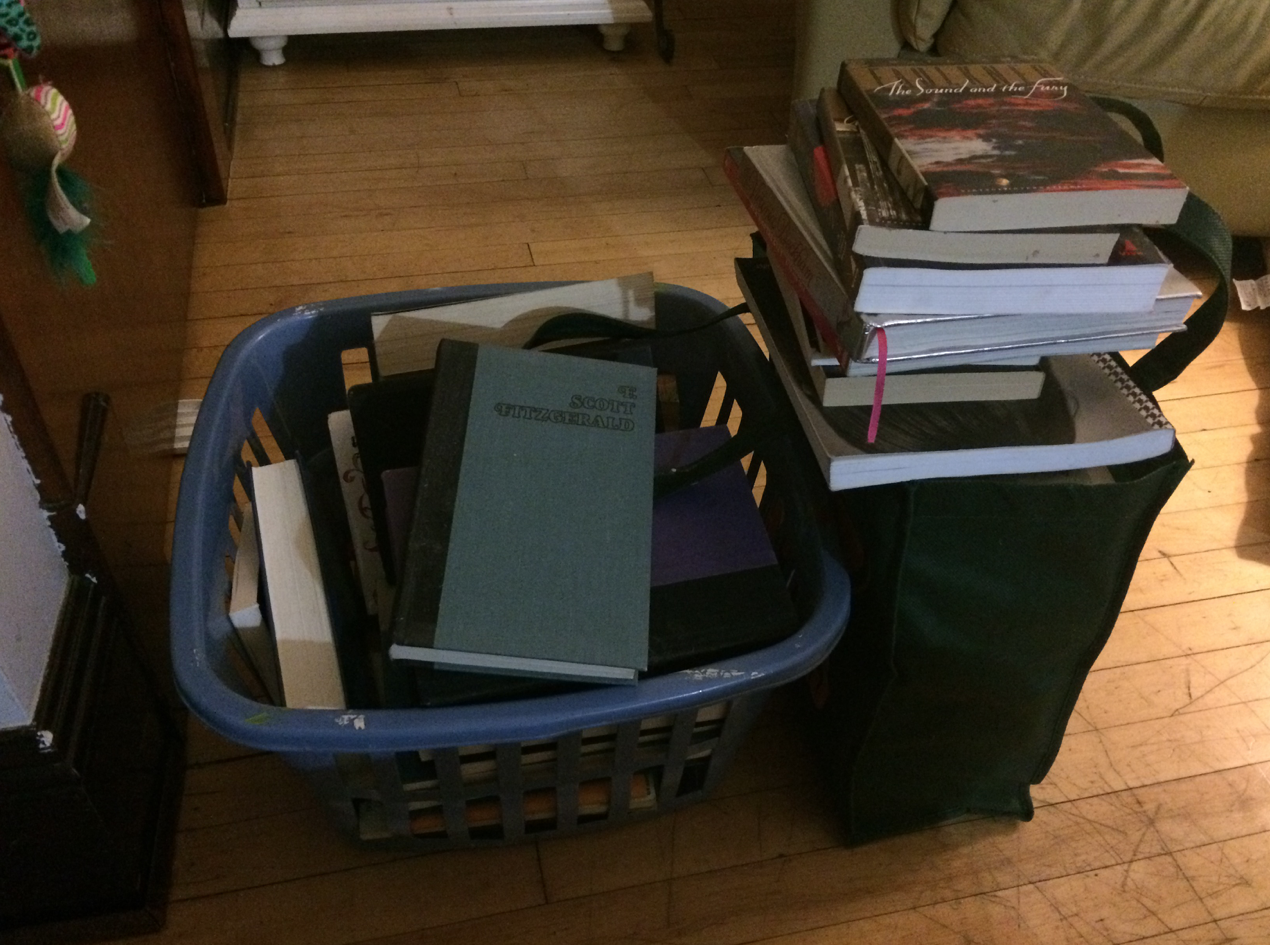
I am that pretentious person that derives a lot of pleasure from having a full bookshelf. I love when I bring men over and they pour over it and tell me what they’ve read too. I love being bored and looking at my shelves and pulling off a book I love, flipping through it and reading the notes I’ve left in the margins.
But Kondo insists that we not keep all our books just to keep them, but to trim ourselves down to a “hall of fame.” And this is an exciting idea — to not be buried in the books I love but to be buoyed by them. To shorten the list down to a singular row of exclamation points that stand solidly in the background as a benchmark for all the things that have shaped me.
A few Kondo-isms that helped in this endeavor:
1. “Books are essentially paper— sheets of paper printed with letters and bound together. Their true purpose is to be read.” If I have read a book, it’s purpose for me is completed. I can discard it and not hang onto the hope that “someday” I will need to reference it again. As we learned with clothing, “someday” never comes.
2. “If you missed your chance to read a particular book, even if it was recommended to you or is one you have been intending to read for ages, this is your chance to let it go.” Don’t hold onto books forever, intending to read them at some future time. If you haven’t read it by now, you won’t.
3. “The moment you first encounter a particular book is the right time to read it.” When you are excited about a book you see or hear about, purchase it immediately and then begin reading it immediately. Holding out on your impulse weakens your desire to read it, and that’s how you end up with so many books you haven’t read.
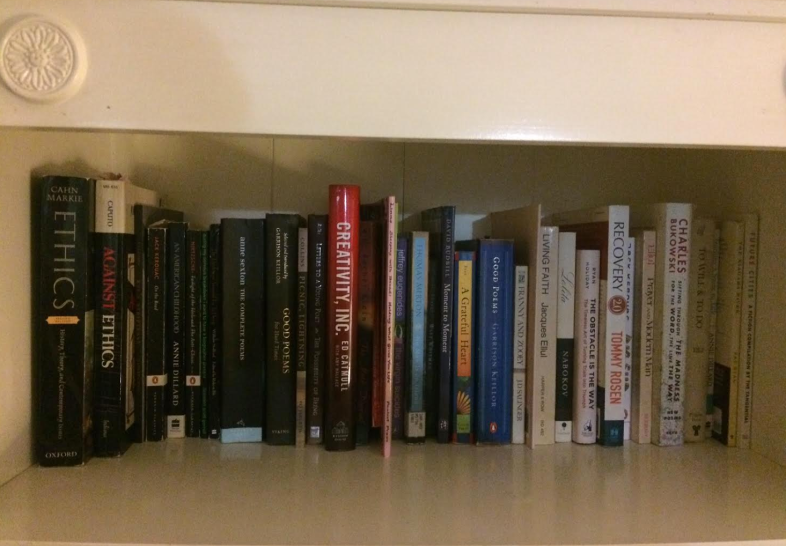
Papers
Kondo’s rule for sorting papers is singular: discard almost everything. By percentage, this was the largest category I discarded. I ended up keeping almost nothing.
We do not need the papers we keep. Almost all papers have fulfilled their purpose the minute we first set eyes upon them: bank statements, bills, letters, offers, etc. But we hoard paper in astronomical amounts. We keep bills and statements after we have viewed and paid them, we keep instruction manuals for appliances we have long discarded, we keep cards and letters from people we don’t even want to think sentimentally about anymore. I consider myself a minimalist, I have gone through my things many times in order to simply my belongings, and yet, look at all these papers I had saved through the years!
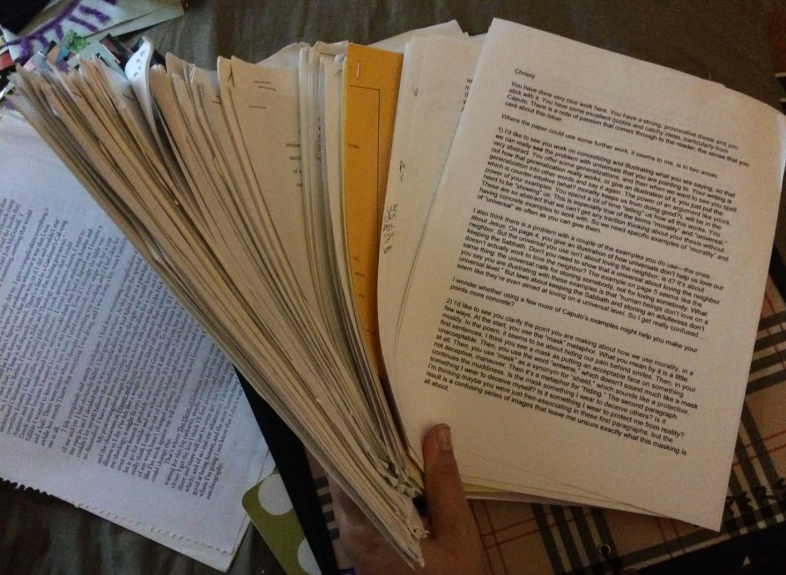
I saved a mountain of academic papers I had written because I thought I would revisit them and keep learning, and yet, in the 15 years since I had written some of them (I kept some from High School!) I had never looked back on them with anything but a quick, amused nostalgia. The second reason I kept them was that I thought when I become a great writer I will look back on them and find things to rewrite or just see the genius I had before I’d figured out how to channel it (which, LOL). The only thing that happened when I did reread them is a lot of cringing.
I have great memories of some of the papers I’ve written, but I have those memories with or without the physical copies taking up space in my closet. It’s not even the words I have typed onto the paper, but the lessons I learned through writing it, which are learned and used and already built upon, I don’t need the receipts.
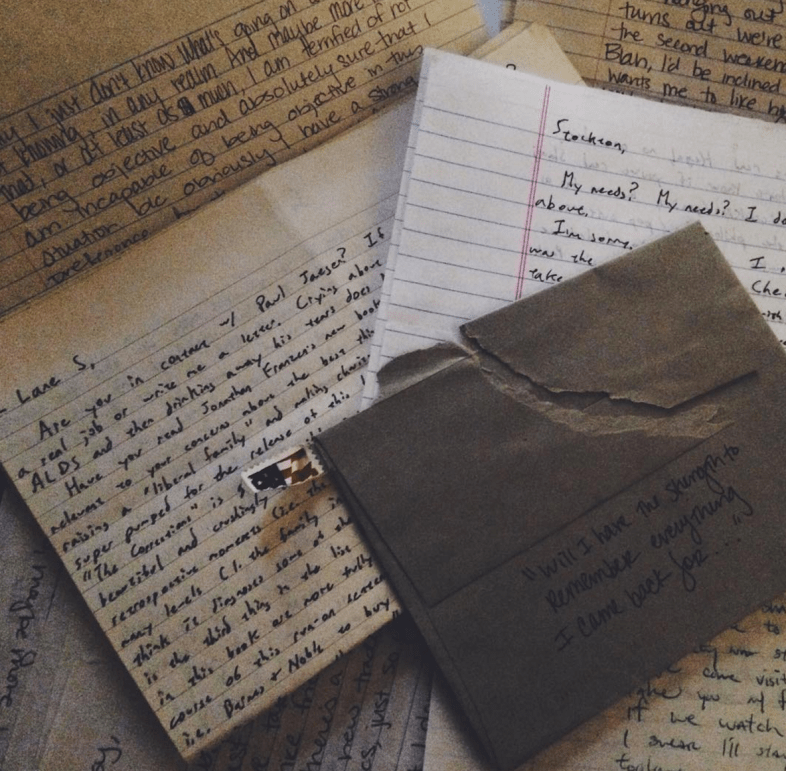
I also had a large volume of handwritten letters because keeping up with loved ones who live far away is one of my favorite pastimes. Writing letters is a very zen practice. It helps your organize your thoughts and catch up with people in an authentic, focused and meaningful way. The letters you receive back are a treasured reminder of this. Though, it’s obvious that the purpose of a letter is fulfilled the moment you send or read it. Letters rarely make sense when read months or years later because they are part of a specific conversation, half of which you sent off and have forgotten about. I ended up discarding them even though they were treasured possessions. I realized I treasured the idea and memory of them, not the physical reminder that those memories exist.
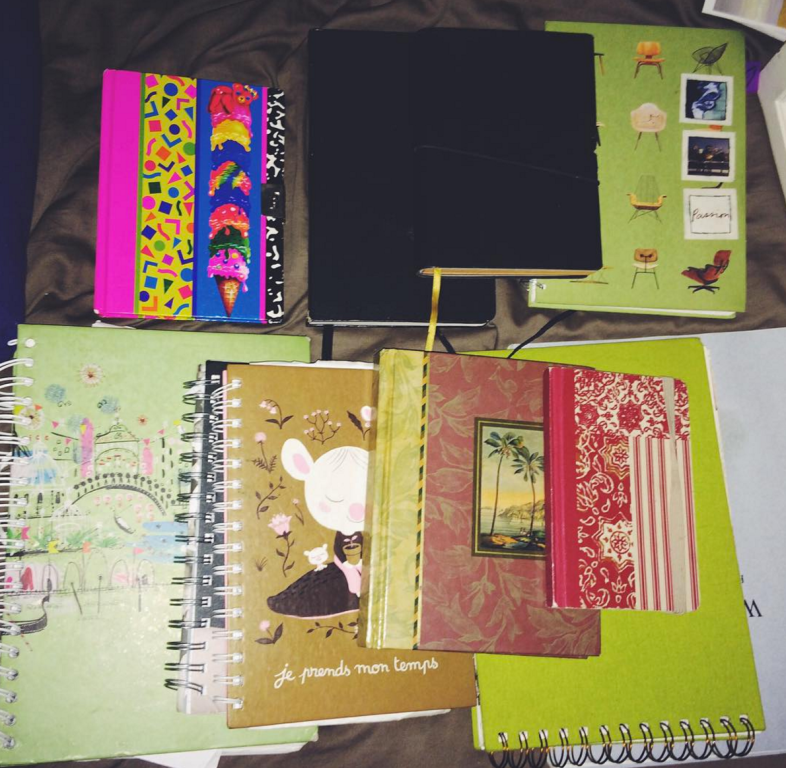
The one indulgence from my papers I kept were all my journals I’ve been writing in since I was six and I rode my bike to Walmart to buy my first (Lisa Frank) journal. These spark so much joy in me because they are so representative of who I am and all the things I have overcome in my life. They are my most treasured possessions and seeing them in my journal drawer always gives me a burst of good feelings.
Kondo isn’t about minimalism, you can keep as much as you want — as long as each item you do keep brings joy into your life.
Kitchen/Practical items
By now, you’re in the groove with Kondo and utilitarian items are boring to talk about so the only important thing to remember here is that if it’s hard to consider whether your blender “sparks joy” remember that gratitude can be a synonym of joy. Are you grateful because the blender does it’s job every morning when you make your green smoothie? Great, keep it and find a home for it. Do you feel a lack of gratitude because you bought the blender with the intention of starting a health fad you never followed through on? Thank the blender for teaching you what you are and are not interested in doing as part of your daily health routine and move on. The blender has fulfilled it’s purpose which was the thrill of buying it and the lesson of what you will realistically use. Let it go.
Items that don’t fit neatly into a category
Kondo calls these items “komono” or miscellaneous. They are the contents of our junk drawers and closets and all the things we keep in various places in case they are useful to us in some distant future. This includes:
1. CDs/DVDs
2. Bathroom/Beauty products
3. Accessories
4. Valuables (credit card, passport)
5. Appliances (digital camera, laptop, cords)
6. Household equipment
7. Household supplies
8. Other (spare change, figurines)
The ultimate wisdom for this category is “If you see a cord and wonder what on earth its for, chances are you’ll never use it again.” Here, still, the goal is to “keep things because you love them, not just ‘because.'”
Finding a home for every item
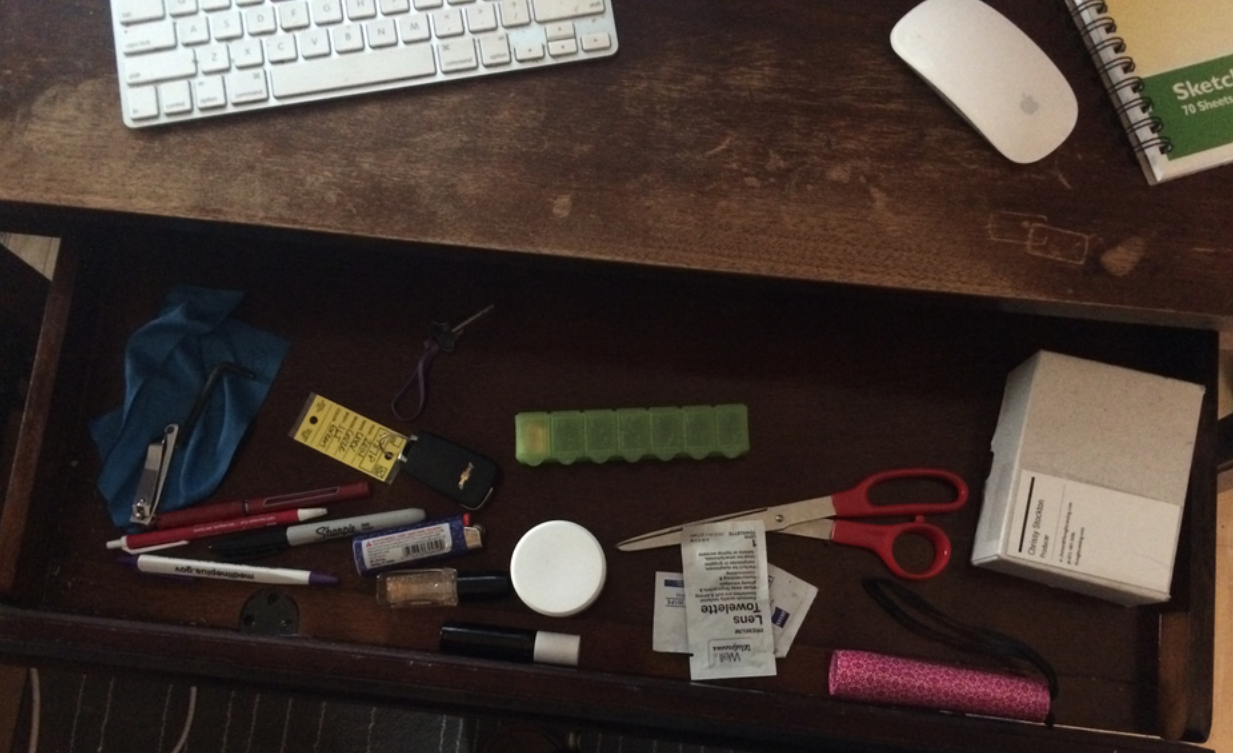
When you are finished discarding, you have to find a place for each item to live. Remember, these are all items that bring you joy — store them accordingly. Don’t shove things haphazardly into a drawer, place them in a way that respects the joy they bring you.
When Kondo talks about her success, she says her clients never relapse. Finding a home for everything is an important part of preventing clutter relapse because when something doesn’t have a home, it ends up constantly sitting on top of a desk or a dresser: “Clutter has only two possible causes: too much effort is required to put things away or it is unclear where things belong.” And, like a magnet, clutter always attracts more clutter.
One of the best parts of designating a home for everything was cleaning my bag out. I tend to like carrying large leather bags I can fit my macbook in if I need to, so I never worry about carrying everything from my bus pass to my checkbook with me — there’s room. But once I found a home for all my everyday items, I started leaving the house with just a wallet and I felt so much lighter and more put together. I can still use a large bag if I want, but there isn’t six inches of random crap on the bottom.
The results
Months after I completed applying the entire KonMari method to my house, I’m still benefitting from it. She doesn’t live entirely up to her claim, it’s not that I never tidy up, but more time passes between tidying sessions. What’s even more important, is that I feel more joy in my space. When I tidy, it is a process of going back to who I am and what I want my life to be like instead of a boring chore. This is, as Kondo says, her whole point “The question of what you want to own is actually the question of how you want to live your life.”
Here’s what my desk used to look like on a day to day basis:
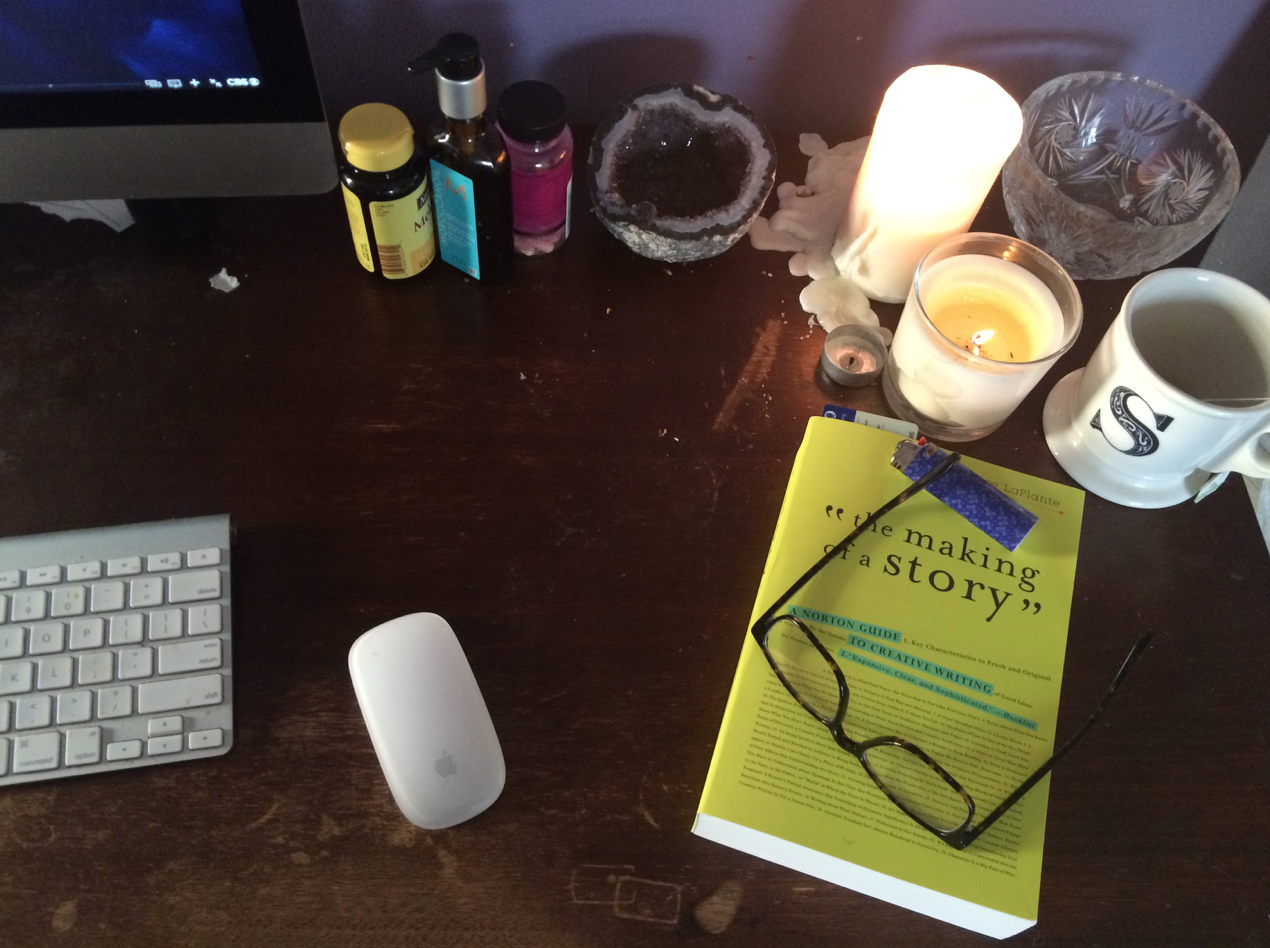
This is an Instagram shot, but it’s also a good example of how things manage to stay in their order long after I finished Kondo-ing, so that some morning when I feel like taking a picture of my breakfast, I don’t have to move anything around first:
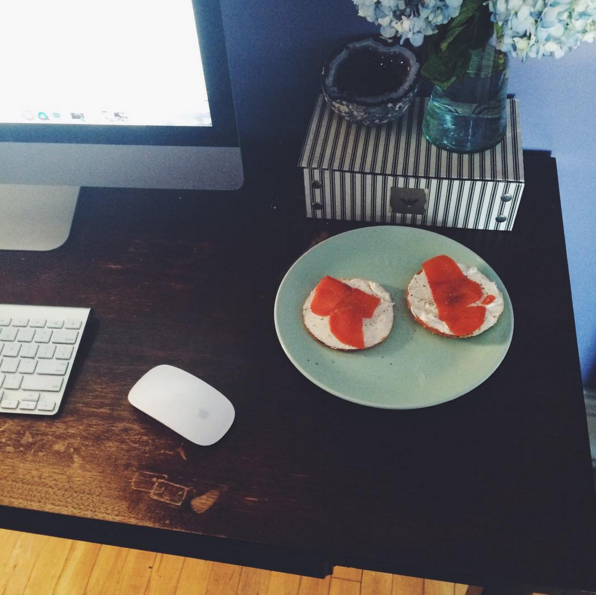
One habit I picked up after I completed the method is to buy fresh flowers regularly. I buy hydrangeas which, if you take care of them, can last a few weeks for a $7 bouquet. I pay more attention to the things that spark joy in my life, and lacking clutter, I have the space to pursue them.
Life is different when your physical world is in order. Again, move the body and the mind follows. If you feel stuck in your bad habits, or like there’s a secret (better) person inside you that hasn’t grown into reality yet, pick up the book, spend a weekend going through your stuff, see who you are when you are surrounded only by joy. ![]()
